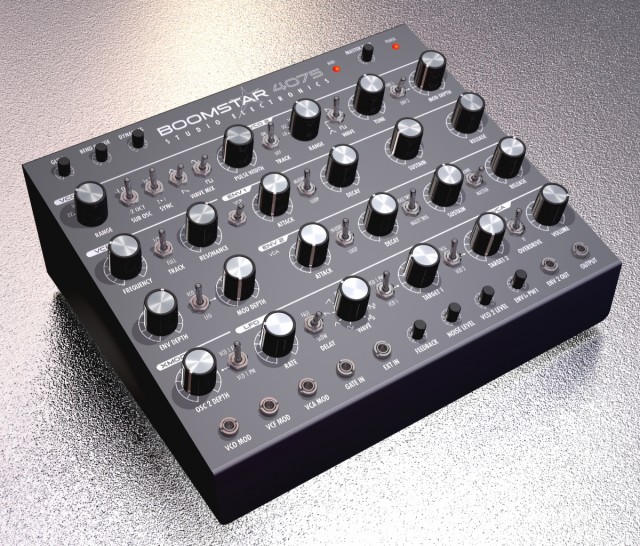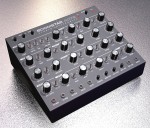
Studio Electronics today introduced the Boomstar family of synthesizers – four new analog synths, each priced at $899.
The four synths share a common 2-oscillator analog synth architecture. The synth is offered, though, with four different filter types:
- 4075-classic Arp 2600
- 5089-classic Moog 24db ladder
- SEM-classic Oberheim 12db
- 303-classic Roland TB.
SE calls the Boomstar “the ultimate desktop analog synthesizer for those who remember the electronic analog sound”.
Here’s a gallery of the synths in the Boomstar line:
Here are the full specs:
Construction
- Sturdy steel chassis, 21 metal shaft pots, 8 knob-less plastic shaft pots, 18 chrome metal toggle switches, (16 three way for expanded functionality), Through hole circuit boards, AC power adaptor
Dimensions
- Panel, 8.7″ wide x 7″ high, Height, 1.75″ at front, 3.25″ at back
Sound Generation
- Discrete voltage controlled analog oscillators, filter, amplifier and envelopes. Hand matched transistors in filter and amplifier. No Curtis chips.
Oscillator 1
- Center off switch for selection of individual or combination of sine, triangle,
- saw, and square waveforms, pulse width modulation by Envelope 1 and/or software LFO.
- Two octave position sub square waveform. Bi-directional 1to2 or 2to1 oscillator sync. Five
- position octave range switch. Modulation of frequency or pulse width by Oscillator 2 with
- depth control.
Oscillator 2
- Sine, saw or square waveform. Fine tune control. Six octave range switch with LO
- frequency position. Keyboard tracking on/off switch. Modulation by Envelope 1 or Envelope 2
- with depth control. Level control.
Noise generator
- Level control.
Filter
- Frequency and resonance with 1/3 or full keyboard tracking. Envelope modulation control. LFO or Oscillator 2 modulation control.
Filter types
- 4075-classic Arp 2600, 5089-classic Moog 24db ladder, SEM-classic Oberheim 12db, 303-classic Roland TB.
Envelopes
- Four-stage with attack decay, sustain, and release. Invert, loop, and drone functions. In Master mode, Envelope 2 modulates both the Filter and Amplifier for simple, one envelope operation. Envelope 1 retains modulation control of other parameters. Single or multiple triggering of attack and decay stage. Envelope 1 dynamics control.
Amplifier
- Two position overdrive. Volume control. Feedback control routes output back into filter and amplifier.
LFO
- Midi syncable software generated sine, triangle, saw, reverse saw, narrow, normal, and wide square, random, and slew random waveforms. Two speed delay function for LFO depth. Depth control for Oscillator 1 frequency or Oscillator 1 pulse width. Depth control for Oscillator 2 frequency or VCA level. Rate control, position determines sync division.
Additional features
- Master tune, glide time, and bend range controls, midi and power indicator leds.
Patch points
- VCO, VCF, VCA, and gate inputs. External audio input. Envelope 2 and osc 1&2 pre-filter output.
MIDI Modulators
- Volume, glide, modwheel to LFO, bender and dynamics. In, out and thru jacks.
MSRP: $899.00





I’ll take one of each!
Sweet! Looking forward to hear these. Especially the ARP. Now please make the missing one with the CS80 filter too:)
This is what the Minitaur should have been…..
wow. if these deliver i am taking all four. se is a serios company. this will be great.
If it has EG2 and VCO outs, why cant there be CV and Gate outs? Still I love the hands-on-ness of this thing, so I’m pumped.
SE is one of those weird companies Ive always appreciated but the price of their synths kept them from my reach. A few years ago I bought an SE-1 though and then I understood what the fuss was about… it ended up being my main bass synth for years.
Man, Im kind of gas-ing for the SEM version… no audio demos yet or real photos. Would have been cool is they could have tied in all of those filter emulation in one unit like they did with the ATC.
pff, only four ?
2012 is very expensive!!!
love the concept but really wish that since the only thing that is different on each is the filter that they’d made the core synth then the filters as add-on modules like in their other synths. Lovely concept though and a great price.
I came.
I saw.
I conquered.
These look brilliant but with a minitaur and minibrute on top that’s 4000 big ones!
Love the form factor. Would be great to mount them all in a line into one big synth-shaped unit
So getting a cv out for env1 and the lfo would cost how much more ?
There are times that i don’t get how these companies think or operate.
There is at this moment a “authentic” sem with 33 patch points.
How exacly do they imagine themselves competing with that ???
The BoomStar has a way more capable and versatile synth engine and midi. I think that’s where they have the competitive edge. For me, it’s the sound and what I can do with it, that matters most. Can’t wait to hear it. 30 plus knobs, yes!
There must be something hidden beneath the text, because i cannot see how it is more powerful.
None of them are powerful, but at least the sem can communicate with anothr system and create something powerful..
After all if you want midi you can get a sem with 21 cv patchpoints
Not to mention that one of them is a sem, the other is trying to be one,
and of course the software lfo !
Patch points, legendary sound, one of my favorite synths ever, SEM wins. Xmod, multiple waveforms with two way sync, four stage envelopes with looping, and triggering goodies, different filters, feedback, overdrive, midi, SE sound quality, BoomStar wins. Bottom line, I’d be thrilled to have them both. Maybe, something we can agree on. Cheers.
… a couple of months later – and still nothing from studio electronics. No demos, updates or whatever. And the expected delivery date is June… wtf?!
No serious producer uses boomstar lol.Moog is where it’s at.If you’re a serious producer,buy Moog.
Only listened to the demos, and looked at the specs here. Judging from that it’s more or less an ATCX with knobs and one filter only?? I’d like to know how smooth it turns between values and how snappy the envelopes are.
I have a feeling that Studio Electronics have developed only one synth after they stopped cannibalising the old analogs to put them into racks with MIDI. And that they’re packing their synth in various shapes and sizes.. ranging from their rack monosynth to a fully built out Code 8.. With a minor OS upgrade here and there – and add ons like the midiminafy-mod, not to mention the CS80-filter for the Omega and Code. But the basic design seems to be the same..
.. not to menion their hang to issue new faceplates more often than a normal person would change his socks. I think it’s a pity that moog into the same pit with their numerous voyager-versions (apart from the XL that is).
The Studio Electronics synths sound good tho’ – always.